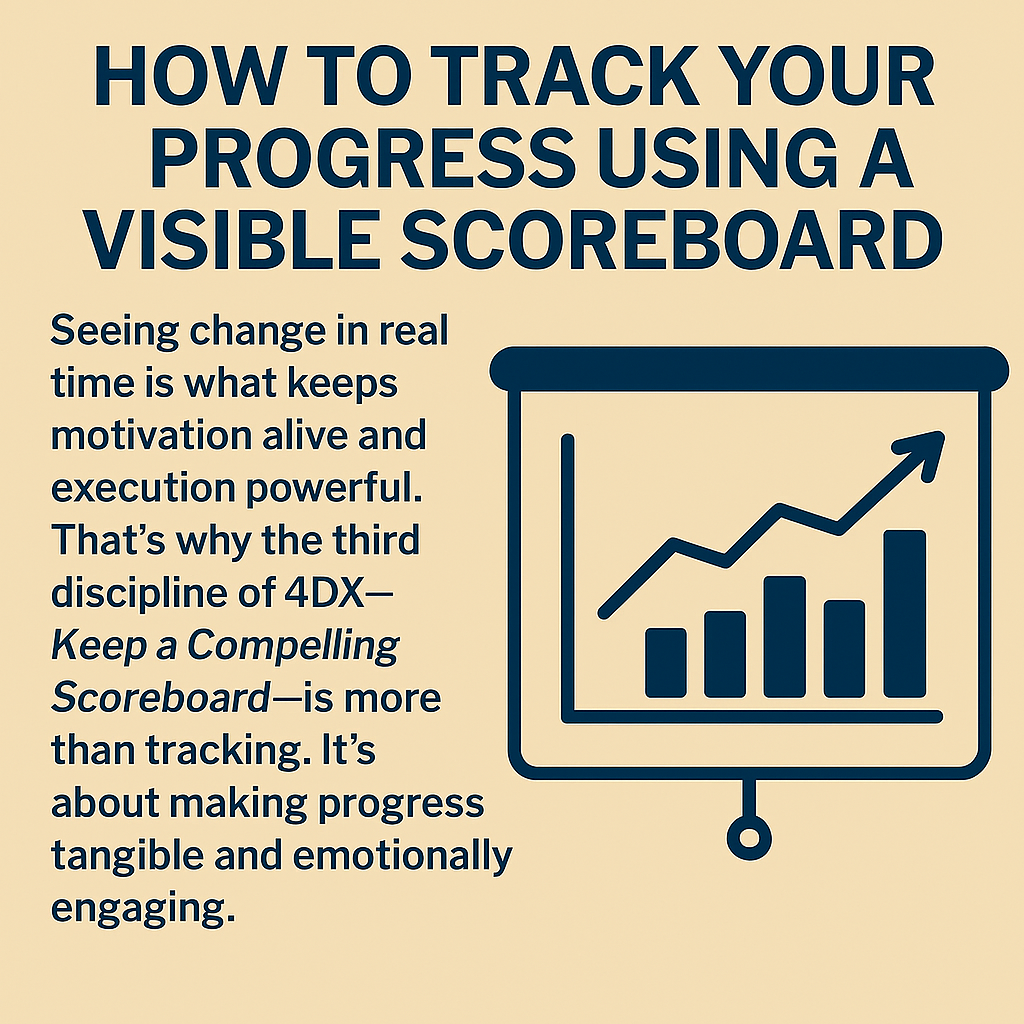Seeing change in real time is what keeps motivation alive and execution powerful. That’s why the **third discipline of 4DX—Keep a Compelling Scoreboard—is more than tracking. It’s about making progress tangible and emotionally engaging.
In this article, you’ll discover how to create, maintain, and leverage a visible scoreboard to monitor your goals and stay on track toward success.
Why Visibility Matters
A scoreboard helps answer:
- “Are we winning?”
- “Where do I stand right now?”
- “What do I need to do next?”
Human brains respond to feedback. Visible tracking externalizes your progress and strengthens emotional investment. You’re not just saying you want results—you’re seeing them.
Crafting a Scoreboard That Works
1. Keep It Simple
It needs to be legible at a glance—meaning: big numbers or bars, few metrics, clear layout. If someone takes more than 5 seconds to understand it, it’s too complex.
2. Show Both Lead and Lag Measures
Track your lag measure (outcomes) and lead measures (actions). This dual view connects behavior with results.
Example:
- Lag: Total sales this month
- Lead: Number of calls made weekly
3. Use Visual Elements
Use charts, progress bars, color shading—e.g., green for on-target, yellow for caution, red for behind. Visual cues are more immediate than raw data.
4. Make It Visible
Place your scoreboard:
- In a shared channel (Slack, Notion) for teams
- On the wall of your home office
- Front and center in your planner or dashboard
Updating the Scoreboard Regularly
When should you update?
- Lag measures: Weekly (or as per your rhythm)
- Lead measures: Daily or weekly, depending on your workflow
Consistency is more important than frequency. Build a habit—like Sunday evenings or Friday afternoons.
How to update?
- Manual entry: Color codes or tick-offs
- Automated: Use Google Sheets with scripts or apps (Trello, Asana, Airtable)
Making It a Team Habit
For teams, a live scoreboard fosters engagement and alignment.
Best practices:
- Well-defined ownership: assign who updates what
- Spotlight progress in meetings (15–30 min WIG session)
- Recognize achievements directly on the board—make wins public
This structure creates a sense of shared responsibility and success.
Spotting Trends and Adjusting
A good scoreboard does more than display data; it informs action. Ask:
- Are lead measures translating into lag progress?
- Is there a plateau or drop-off?
- What changes can we make—lead measures, timing, resources?
Reflect at your weekly checkpoint. Visibility turns insight into adaptation.
Avoid These Common Problems
- Overloading data: Stick to the essential few metrics
- Hiding it apart: Make it always visible
- Ignoring it: Review and update consistently
- Making it static: Scale or evolve it as goals shift
Real-Life Example: Freelancer’s Income Tracker
WIG: “Double monthly client income from R$5,000 to R$10,000 by July 31”
Lead: Number of client proposals sent, networking events attended
Lag: Weekly total earnings
The scoreboard includes:
- Weekly bar chart for earnings
- Checkboxes for each proposal sent/week
Freelancer updates it every Friday and uses colors to visualize status—green for on-track, yellow for slightly behind.
Each Monday, a quick reflection: “Did I send 5 proposals? Yes. Income: R$2,600.”
Start Your Scoreboard Today
- Define your WIG and its lead/lag measures
- Choose your visual format (digital or physical)
- Design it to be clear, simple, and emotionally engaging
- Assign updates and schedule review time
- Use it for motivation, insight, and course correction
Final Thought
A visible scoreboard turns abstract goals into a live story of progress. It keeps you honest, motivated and in touch with reality. With 4DX, this isn’t an optional extra—it’s a core component of focused, disciplined execution.
